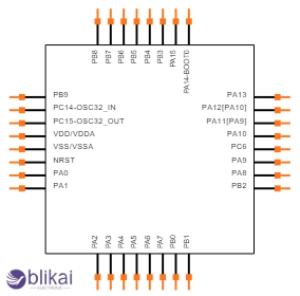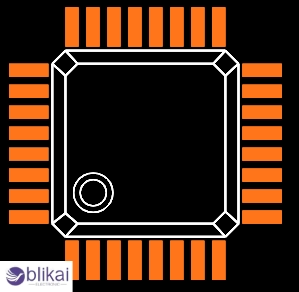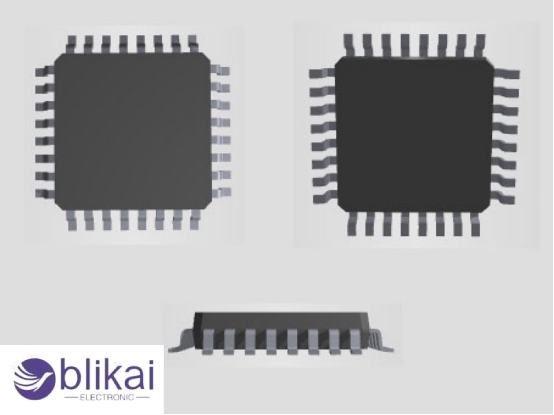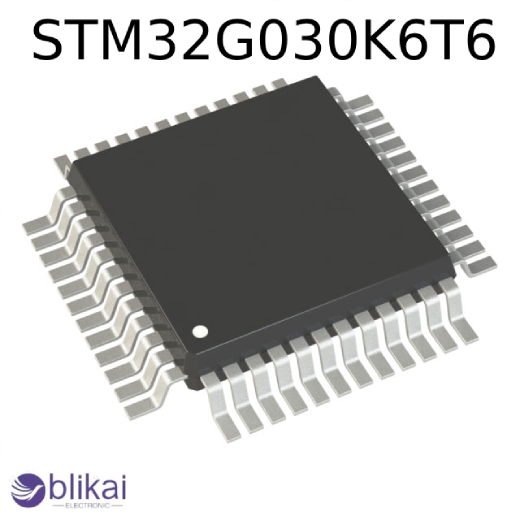STM32G030K6T6 Microcontrollers: Description, Features, and Applications
Product Description
Part Number: STM32G030K6T6
Manufacturer: STMicroelectronics
Description: ARM® Cortex®-M0+ STM32G0 Microcontroller IC 32-Bit Single-Core 64MHz 32KB (32K x 8) FLASH 32-LQFP (7x7)
Lead Time: Can Ship Immediately
Datasheet: Datasheet PDF
Category: Single Chip Microcomputer/Microcontroller/Microcontroller Units (MCUs/MPUs/SOCs)
Number of Pins: 32
Short Description
Microcontroller STM32G0 Series 3V 32-LQFP with 32KB 32K x 8 FLASH ARM® Cortex®-M0+. Its 32-bit RISC core, which operates at 64 MHz, is based on the high-performance Arm® Cortex®-M0+ microcontroller. An overview of its features, applications, and datasheet will be presented in this article.
The STM32G030x6/x8 microcontrollers feature a 32-bit RISC core running at a high frequency of 64 MHz, the Arm® Cortex®-M0+. Suitable for a variety of consumer, industrial, and appliance applications, they are ready for Internet of Things (IoT) solutions.
DMA, a memory protection unit (MPU), and fast embedded memories (up to 64Kbytes Flash program memory) can all be found on the board. Additionally, there are many new system functions and enhancements to I/O and peripherals. Two I2Cs, two SPIs / one I2S, two USARTs, four 16-bit general-purpose timers, and two watchdog timers, as well as a low-power RTC, an advanced control PWM timer, and an advanced control PWM timer are also included. For general-purpose use, there is also a low-power RTC and PWM timer as well as four 16-bit timers.
The devices operate between -40°C and 85°C. The supply voltage needs to be between 2.0 V and 3.6 V for them to run. Optimised dynamic consumption and various power-saving modes enable low-power application design.
Product Specification
STM32G030K6T6 Design
Pinout

CAD Model

Symbol

Footprint

3D Model
STM32G030K6T6 Features
Core and Architecture:
A maximum frequency of 64MHz is supported by the ARM Cortex-M0+ core.
For efficient processing, RISC architecture is 32 bits.
Memory:
For program storage, there is a 32 KB flash memory.
For data storage, SRAM has 8 KB.
Clock and Power Management:
RC oscillator with a frequency of 16 MHz.
In order to multiply clock frequencies, PLLs (Phase-Locked Loops) are used.
Energy-efficient modes with low power consumption.
Peripheral Interfaces:
Flexible interfacing with 51 GPIO pins.
Multiple serial communication interfaces such as USART, I2C, and SPI are available.
Precision timers and counters for producing pulse-width modulations (PWMs).
For interfacing analog sensors with digital devices, analog-to-digital converters (ADCs) are used.
Communication Protocols:
Communication protocols such as I2C, SPI, and USART are supported.
Standard and fast I2C and SPI interfaces.
Asynchronous and synchronous USART modes are available.
Analog Components:
Analog signal conversion using 12-bit ADCs.
For generating analog output signals, DACs (Digital-to-Analog Converters) are used.
Security Features:
Data integrity is determined by calculating CRCs (Cyclic Redundancy Checks).
Generators for cryptographic applications based on hardware random numbers.
Interrupt and Event Handling:
The NVIC (Nested Vectored Interrupt Controller) is designed to handle interrupts efficiently.
Controllers for interrupts and events external to the system.
Development and Debugging:
Debugging and programming can be done via Serial Wire Debug (SWD) and JTAG interfaces.
Programming and firmware updating are performed through the bootloader.
Operating Voltage:
It usually operates between 1.7 V and 3.6 V.
Temperature Range:
As a result of its extended temperature range, it can be used in a variety of environmental conditions.
Package Options:
Various package options are available, including LQFP, UFQFPN, and others, enabling flexible board design.
DMA (Direct Memory Access):
Using a DMA controller, peripherals and memory can be communicated efficiently without involving the CPU.
CRC Calculation Unit:
In data communications, hardware CRC calculation units are used to check for errors.
Low Power Modes:
During idle periods, power consumption can be reduced by sleeping, stopping, or entering standby mode.
Unique Device ID:
Secure device identification using an identifier unique to each device.
GPIO Configurable Pull-Up/Pull-Down Resistors:
A GPIO pin can be configured to connect up or down with pull up/pull down resistors.
Bit-Banding Support:
Individual bits in peripherals can be addressed via bit-banding.
Safety and Reliability Features:
Data integrity is determined by calculating CRCs (Cyclic Redundancy Checks).
A system reliability watchdog timer that operates independently.
Applications
IoT Devices:
As an Internet of Things (IoT) chip, the STM32G030K6T6 is suitable for interfacing sensors, processing data, and communicating with the cloud.
Home Automation:
Smart devices, sensors, and communication between components can all be controlled by the microcontroller in home automation systems.
Industrial Automation:
In addition to controlling motors and monitoring industrial processes, the microcontroller is suitable for controlling systems and controlling motors in industrial automation applications.
Motor Control:
A STM32G030K6T6 is suitable for robotics and automation applications that require motor control.
Battery Management Systems:
Battery management systems can use microcontrollers to monitor charges, discharges, and levels of batteries in battery-powered devices.
Smart Agriculture:
Microcontrollers can be used in agriculture to control irrigation and monitor environmental conditions.
Medical Devices:
Signal processing, data acquisition, and control functions can all be handled by the microcontroller in medical devices.
Smart Lighting Systems:
LED lighting, dimming, and color temperature management can be achieved using STM32G030K6T6 in smart lighting systems.
Sensor Hubs:
A sensor hub uses this microcontroller to gather data from multiple sensors, process it, and transmit it.
Communication Devices:
Communication devices use microcontrollers to handle protocol transmission, such as UART, SPI, and I2C.
Automotive Applications:
In addition to dashboard control and sensor interfaces, the microcontroller can also be used in body control modules.
RFID Systems:
Communication and data processing are handled by microcontrollers in RFID (Radio-Frequency Identification) systems.
Audio Processing:
As well as audio players and musical instruments, microcontrollers can be used for voice-activated systems and voice-controlled robotics.
Faqs
Question 1: What is the STM32G030K6T6 microcontroller?
Answer: From STMicroelectronics, the STM32G030K6T6 belongs to the STM32G0 series of microcontrollers. This ARM Cortex-M0+ core is designed for embedded applications as well as having an ARM Cortex-M0+ core.
Question 2: What is the core architecture of the STM32G030K6T6?
Answer: ARM's 32-bit Cortex-M0+ RISC architecture provides highly efficient processing for embedded systems.
Question 3: What is the maximum clock frequency of the STM32G030K6T6?
Answer: It offers processing power suitable for a range of applications, with a maximum frequency of 64 MHz.
Question 4: What is the memory configuration of the STM32G030K6T6?
Answer: In addition to the 32KB Flash memory used to store data, an 8KB SRAM is available to store programs.
Final Verdict
Ultimately, STMicroelectronics' STM32G030K6T6 microcontroller offers a broad range of applications and is versatile and powerful. The AMD Athlon X2 offers excellent processing power and energy efficiency due to its ARM Cortex-M0+ core and clock frequency of 64 MHz.
In order to cater to the needs of various embedded applications, 32 KB of Flash memory and 8 KB of SRAM are included in the microcontroller's memory configuration. With GPIO pins, USARTs, I2Cs, SPIs, counters, ADCs, and DACs, it offers a variety of capabilities for integrating and communicating with different electronic systems.
Energy-efficient designs can benefit from microcontrollers with low-power modes. In robots and automation projects, the STM32G030K6T6 can control and drive motors effectively in motor control applications. Microcontrollers have CRC calculation units and hardware random number generators that enhance data integrity and security. There are various packages available, including LQFP and UFQFPN, which allow for different board layout requirements to be accommodated.
Related Articles
Microcontroller vs Microprocessor: What's the Differences? (Guide)
Embedded Systems vs Microcontrollers: What's the Main Differences?
ARM Microcontroller : Features,Applications and Function
What is ARM7 Based (LPC2148) Microcontroller ?All Explained
STM32F030F4P6 Microcontroller: Overview, Applications, and Datasheet
STM32F407IGT6 Microcontroller: Features, Applications and Datasheet
Comparing FPGA vs Microcontroller: Optimal for Your Needs?
Differences Between FPGA vs Microcontroller
STM8S005K6T6C Microcontroller: Features, Apps & Datasheet Insights
ATMega328P Microcontroller: A Powerful Microcontroller
How to Test a Hard Start Capacitor [Complete Guide]
ESP32 vs ESP8266: Which One Should You Choose?
Difference Between Isolator and Circulator? [Guide]
Understanding Coupled Inductors: Operations and Practical Applications











